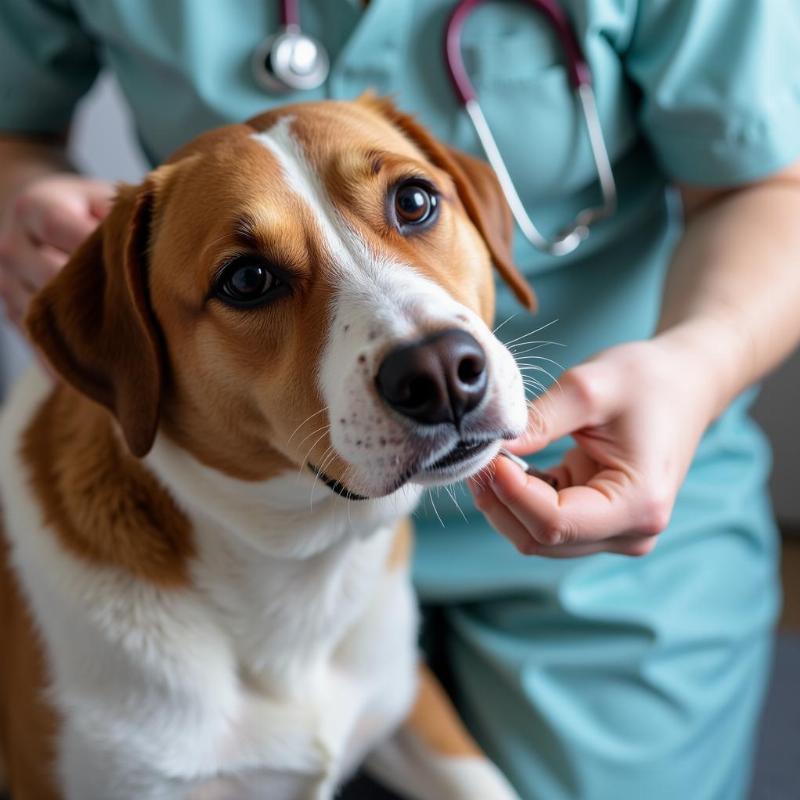Discovering a lump on your dog’s neck, especially one the size of a tennis ball, can be alarming. This article will guide you through the potential causes, diagnostic processes, and treatment options for such lumps in dogs within the United States, providing you with the information you need to ensure your furry friend receives the best possible care.
Understanding the Causes of Tennis Ball Sized Lumps on a Dog’s Neck
Several factors can contribute to the development of a tennis ball sized lump on a dog’s neck. These can range from relatively harmless issues like lipomas (fatty tumors) or abscesses to more serious concerns like cancerous growths or swollen lymph nodes. Age, breed, and overall health can also play a role.
Is the lump hard or soft? Does it seem to bother your dog when you touch it? Is it growing rapidly? These are all important questions to consider when assessing the lump. Observing these characteristics can help your veterinarian narrow down the possible causes.
Diagnostic Procedures for Identifying the Lump
If you find a lump on your dog’s neck, the first and most crucial step is to schedule a visit with your veterinarian. They will perform a thorough physical examination and may recommend further diagnostic tests to determine the nature of the lump. These tests may include:
- Fine Needle Aspiration (FNA): This procedure involves inserting a thin needle into the lump to collect cells for microscopic examination. It’s a minimally invasive procedure often performed in the office.
- Biopsy: A biopsy involves removing a small tissue sample from the lump for analysis. This provides a more definitive diagnosis than FNA.
- Imaging Tests: X-rays, ultrasounds, or CT scans can help determine the size, location, and extent of the lump, as well as its impact on surrounding tissues.
 Dog Getting Fine Needle Aspiration
Dog Getting Fine Needle Aspiration
Treatment Options Based on Diagnosis
Treatment for a lump on a dog’s neck depends entirely on the underlying cause.
- Benign Tumors (like lipomas): Often, no treatment is necessary. However, surgical removal may be recommended if the lump interferes with the dog’s movement or comfort.
- Abscesses: These typically require draining and antibiotics.
- Cysts: These fluid-filled sacs may be drained or surgically removed.
- Cancerous Tumors: Treatment options may include surgery, chemotherapy, radiation therapy, or a combination of these. Early detection and diagnosis are crucial for successful treatment.
When is a Lump on a Dog’s Neck an Emergency?
While not all lumps are emergencies, rapid growth, pain, bleeding, or difficulty breathing warrant immediate veterinary attention. If the lump suddenly changes in size, color, or texture, it’s essential to consult your vet promptly.
Conclusion: Taking Action for Your Dog’s Health
Finding a tennis ball sized lump on your dog’s neck can be concerning, but with prompt diagnosis and appropriate veterinary care, the prognosis can be positive. Don’t delay seeking professional help. Early intervention is key to ensuring the best possible outcome for your beloved companion.
FAQ
- Can a tennis ball sized lump on my dog’s neck be cancerous? Yes, it’s possible. While some lumps are benign, cancerous tumors can also occur. Only a veterinarian can determine the nature of the lump through diagnostic tests.
- What should I do if I find a lump on my dog? Schedule an appointment with your veterinarian as soon as possible for examination and diagnosis.
- Are all lumps on a dog’s neck dangerous? No, not all lumps are dangerous. Many are benign and require no treatment. However, it’s crucial to have any lump evaluated by a veterinarian to rule out serious conditions.
- How much does it cost to diagnose and treat a lump on a dog’s neck? The cost varies depending on the diagnostic tests required and the chosen treatment plan. It’s best to discuss costs with your veterinarian.
- Can I try home remedies for a lump on my dog’s neck? No, it’s crucial to avoid home remedies and consult your veterinarian for proper diagnosis and treatment. Attempting home remedies can delay necessary medical intervention and potentially worsen the condition.
- How can I prevent lumps from developing on my dog’s neck? While not all lumps are preventable, regular veterinary check-ups can help detect any abnormalities early. Maintaining a healthy diet and lifestyle for your dog can also contribute to overall well-being.
- What are the signs that a lump on my dog’s neck is an emergency? Rapid growth, pain, bleeding, difficulty breathing, or sudden changes in size, color, or texture warrant immediate veterinary attention.
Beautdogs.us: Your Trusted Source for Dog Care
Beautdogs.us is your premier online destination for comprehensive and engaging information on dog breeds, care, and lifestyle in the United States. We cater to both novice and experienced dog owners, offering expert advice on everything from breed-specific needs to the latest trends in pet care. Our mission is to empower you with the knowledge and resources necessary to provide your canine companion with a happy, healthy, and fulfilling life. Learn more and connect with our team of experts at [email protected] or call us at +1 501-555-7529.